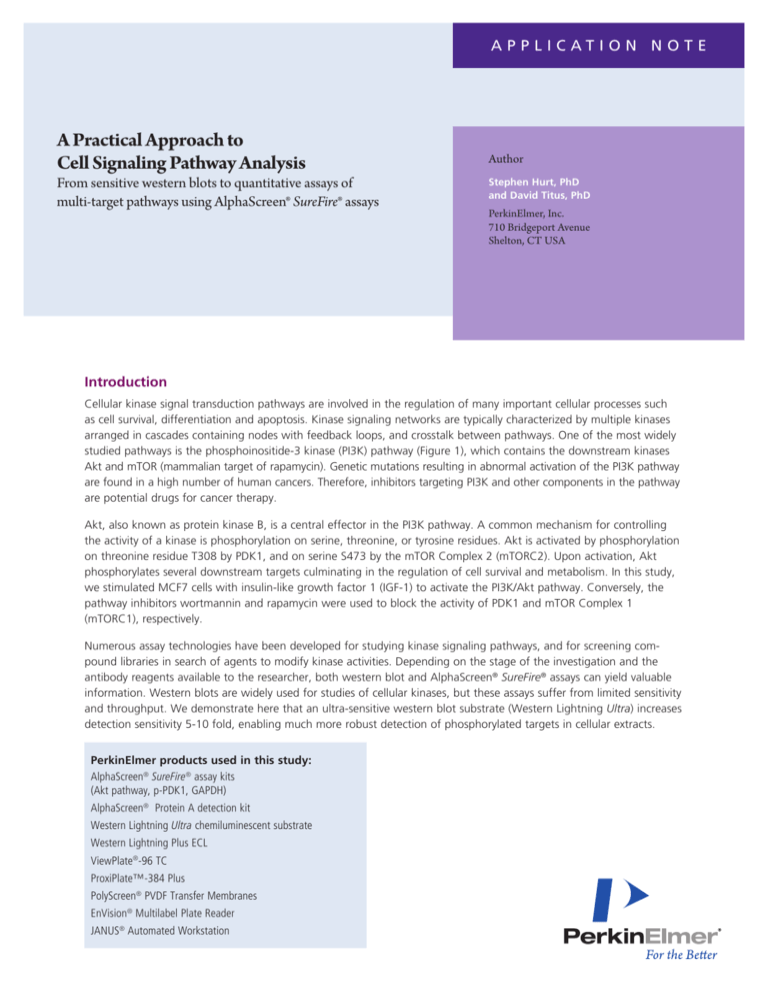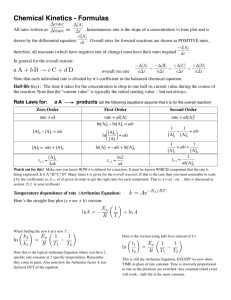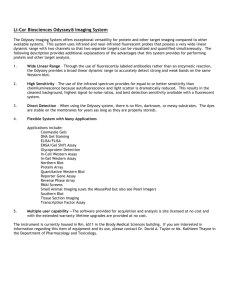
a p p l i c at i o n N o t e
A Practical Approach to
Cell Signaling Pathway Analysis
From sensitive western blots to quantitative assays of
multi-target pathways using AlphaScreen® SureFire® assays
Author
tephen Hurt, PhD
S
and David Titus, PhD
PerkinElmer, Inc.
710 Bridgeport Avenue
Shelton, CT USA
Introduction
Cellular kinase signal transduction pathways are involved in the regulation of many important cellular processes such
as cell survival, differentiation and apoptosis. Kinase signaling networks are typically characterized by multiple kinases
arranged in cascades containing nodes with feedback loops, and crosstalk between pathways. One of the most widely
studied pathways is the phosphoinositide-3 kinase (PI3K) pathway (Figure 1), which contains the downstream kinases
Akt and mTOR (mammalian target of rapamycin). Genetic mutations resulting in abnormal activation of the PI3K pathway
are found in a high number of human cancers. Therefore, inhibitors targeting PI3K and other components in the pathway
are potential drugs for cancer therapy.
Akt, also known as protein kinase B, is a central effector in the PI3K pathway. A common mechanism for controlling
the activity of a kinase is phosphorylation on serine, threonine, or tyrosine residues. Akt is activated by phosphorylation
on threonine residue T308 by PDK1, and on serine S473 by the mTOR Complex 2 (mTORC2). Upon activation, Akt
phosphorylates several downstream targets culminating in the regulation of cell survival and metabolism. In this study,
we stimulated MCF7 cells with insulin-like growth factor 1 (IGF-1) to activate the PI3K/Akt pathway. Conversely, the
pathway inhibitors wortmannin and rapamycin were used to block the activity of PDK1 and mTOR Complex 1
(mTORC1), respectively.
Numerous assay technologies have been developed for studying kinase signaling pathways, and for screening compound libraries in search of agents to modify kinase activities. Depending on the stage of the investigation and the
antibody reagents available to the researcher, both western blot and AlphaScreen® SureFire® assays can yield valuable
information. Western blots are widely used for studies of cellular kinases, but these assays suffer from limited sensitivity
and throughput. We demonstrate here that an ultra-sensitive western blot substrate (Western Lightning Ultra) increases
detection sensitivity 5-10 fold, enabling much more robust detection of phosphorylated targets in cellular extracts.
PerkinElmer products used in this study:
AlphaScreen® SureFire® assay kits
(Akt pathway, p-PDK1, GAPDH)
AlphaScreen® Protein A detection kit
Western Lightning Ultra chemiluminescent substrate
Western Lightning Plus ECL
ViewPlate®-96 TC
ProxiPlate™-384 Plus
PolyScreen® PVDF Transfer Membranes
EnVision® Multilabel Plate Reader
JANUS® Automated Workstation
IGF-1
Receptor
PI3K
PDK1
mTORC2
AKT
GSK3
mTORC1
Glycogen
Synthesis
4E-BP1
p70S6K
S6 RP
Protein
Translation
Figure 1. The PI3K/Akt cellular signaling pathway
We further compared the detection of multiple phosphorylated
targets using AlphaScreen® SureFire® assays of cellular kinase
activity. Our data indicates that AlphaScreen® SureFire® assays
for several targets in the PI3 signaling pathway give results
comparable in sensitivity to ultra-sensitive western blots, but
with higher throughput and a much less time-consuming protocol. Modulation of kinase pathways generally affects multiple
kinases in the pathway. AlphaScreen® SureFire® assays are
well-suited for kinase pathway mapping, since the assay requires
only 4 µL of cellular lysate per assay point.
The results of cell-based assays can be affected by variability in
the number of cells sampled per assay point. A common method
for controlling for variability is to normalize the assay signal to
a cellular protein whose level does not change as a function of
the assay. We have validated two targets for normalization of
the PI3K/Akt pathway. The first is the metabolic enzyme GAPDH,
and the second is the total Akt present in the cell.
AlphaScreen® SureFire® technology
Western Lightning Ultra chemiluminescent substrate
AlphaScreen SureFire cellular kinase assays measure endogenous levels of phosphorylated cellular proteins involved in various
signaling pathways. The assay is a homogeneous, bead-based
technology that utilizes two antibodies in a sandwich assay
format. One antibody recognizes a specific phospho-epitope
on the analyte, while the other antibody is directed towards
another, non-phosphorylated, epitope on a distal part of the
analyte. One of the antibodies binds to a Donor bead and the
other to an Acceptor bead, so that in the presence of a phosphoprotein the two beads are drawn into close proximity. Excitation
of the Donor bead with laser light with a wavelength of 680 nm
results in energy transfer to the Acceptor bead yielding an
emission signal at 520-620 nm.
The high sensitivity and broad dynamic range of the Western
Lightning Ultra substrate make it ideal for investigation of cell
signaling pathways, where concentration of targets of interest
can vary widely.
®
®
Cell lysate preparation
Flasks of confluent cells were stimulated for 20 minutes at room
temperature with 200 nM IGF-1 in complete medium. The
medium was removed and the cells were lysed with 5 mL of
lysis buffer for 10 minutes with gentle shaking. The lysate was
centrifuged to remove solid cell debris and the supernatant was
collected and frozen in aliquots at -80 °C. Pathway inhibition was
performed by treating the cells with a combination of 20 µM
wortmannin and 200 nM rapamycin in complete medium for
2 hours at 37 °C, 5 % CO2. Cells were serum-starved by
incubation in base medium for 3 hours at 37 °C, 5 % CO2.
Western blot analysis
Figure 2. AlphaScreen® SureFire® assay principle
Cell culture
MCF7 cells were cultured in T75 flasks in EMEM supplemented
with 10% FBS. Cells were maintained in culture at 20-70%
confluency and typically were passed twice per week.
2
Protein concentration in MCF7 cell lysates was determined by
the BCA protein assay with bovine serum albumin as the standard.
Western blot analysis was performed by resolving cell lysates
loaded at 20 µL/lane on NuPAGE® Novex® polyacrylamide mini
gels followed by transfer of the proteins to PVDF membranes.
The membranes were probed with the same primary antibodies
to phospho-proteins contained in the AlphaScreen® SureFire®
kits, followed by exposure to anti-species HRP-conjugated
secondary antibodies. The membranes were treated with the
chemiluminescent substrate for 1 minute, and the image was
acquired on a Kodak Image Station 440 CF imager.
AlphaScreen® SureFire® assay protocol
Pathway mapping workflow
A 4 µL aliquot of lysate was added to the well of a ProxiPlate.
A 5 µL mixture of Reaction buffer, Activation buffer, and
AlphaScreen Protein A Acceptor beads (40:10:1) was added
and the plate was incubated at room temperature for 2 hours.
Two µL of AlphaScreen streptavidin-coated Donor beads in
AlphaScreen® SureFire® Dilution buffer (20:1) was added and
the plate was incubated for an additional 2 hours. The plate
was then read on an EnVision® Multilabel Plate Reader using
the factory defined AlphaScreen settings.
The workflow shown in Figure 3 illustrates an efficient and
cost-effective approach to cell signaling pathway analysis.
By freezing multiple aliquots of the stimulated cell lysate at
-80 °C, a first-pass analysis of one phosphorylated target can
be followed by a more extensive analysis using the full range
of AlphaScreen® SureFire® assays available for a given pathway.
Confirmatory western blots can then be performed on the
same samples only as needed.
Treat cells in culture
flask or microplate.
10-60 min
Lyse cells and collect
supernatant. Freeze
aliquots at -80 °C.
30 min
Analyze phospho-AKT
levels using
AlphaScreen®
SureFire® assay. 5 hrs
Positive results
Negative results
Using a frozen aliquot of
treated cells, perform
parallel analysis of
targets in AKT signaling
pathway. 5 hrs
Try another
cell treatment
Using a frozen aliquot
of treated cells,
perform western blot
confirmation of selected
assay results.
Figure 3. A workflow for efficient analysis
of cell signaling pathways.
3
Western Lightning Ultra
Cell lysate loaded [ug/well]
16
8
4 2
1
Western Lightning Plus
0.5
Cell lysate loaded [ug/well]
16
8 4
2
1
0.5
Figure 4. Sensitivity of detection using Western Lightning Ultra compared to Western Lightning Plus.
Ultra-sensitive western blot
PI3K/Akt pathway mapping: basal vs. serum
starved vs. inhibited cells
Two western blots were run using the same aliquot of lysate
from cells stimulated with IGF-1. Two-fold serial dilutions of
lysate were performed to determine assay sensitivity. The
membranes were probed with antibody to total Akt, and
detected with either Western Lightning Ultra or Western
Lightning Plus. The results shown in Figure 4 demonstrate that
5-10 fold greater sensitivity is obtained with Western Lightning
Ultra as the substrate.
The targets that had shown significant basal levels as described
above were further studied by either serum starving the cells or
treating them with pathway inhibitors. Inhibition was performed
using a combination of two inhibitors, wortmannin and
rapamycin, to ensure maximal inhibition. As observed in Figure 7,
serum starvation reduces the signal for these targets except
p-S6 RP. Pathway inhibition reduced the signal to a greater
extent than serum starvation for all of the targets.
Basal
Stimulated
700,000
600,000
500,000
400,000
300,000
200,000
100,000
1
BP
RP
p4E
3
6
pS
K
pG
SK
)
S6
73
pP7
0
8)
30
S4
t(
p-
Ak
(T
K1
0
pPD
The sensitivity of western blot assays using Western Lightning
Ultra was compared to the sensitivity of AlphaScreen® SureFire®
assays in detecting seven phosphorylated proteins in the PI3K/Akt
signaling pathway. The components tested ranged from PDK1
at the beginning of the pathway to the final downstream targets,
p-4E-BP1 and p-S6 RP, and included both phosphorylation sites
on Akt. Serial dilutions of lysates of IGF-1 stimulated cells show
comparable sensitivity of detection by both assay technologies
as presented in Figure 5 (next page).
800,000
kt
Western blot sensitivity compared to
AlphaScreen® SureFire®
pA
Results
Figure 6. Comparison of basal vs. stimulated level of phospho-proteins in the
PI3K/Akt pathway in cells stimulated with IGF-1.
PI3K/Akt pathway mapping: basal vs. stimulated cells
AlphaScreen® SureFire® assays were used to measure the level
of phosphorylated substrates in the PI3K/Akt pathway compared
to their basal level in cells stimulated with IGF-1. As shown in
Figure 6, four members of the pathway, p-Akt (T308), p-Akt
(S473), p-p70 S6K and p-S6 RP exhibited a stimulated response
from 2-20 fold greater than their basal level. The other three
pathway components did not show stimulation significantly
above their basal level.
400,000
300,000
Basal
Inhibited
Serum Starved
200,000
100,000
0
Figure 7. Effect of serum starvation or pathway inhibition on MCF7 cells.
4
AlphaScreen
SureFire p- AKT (T308)
300,000
Signal (counts)
250,000
p-AKT
Thr 308
200,000
150,000
100,000
50,000
0
34001700 850 425 212 106 53
27
14
ng of lysate/well
AlphaScreen
SureFire p- AKT (Ser473)
250,000
p-AKT
Ser 473
200,000
150,000
100,000
50,000
0
34001700 850 425 212 106 53
27
14
ng of lysate/well
AlphaScreen
SureFire p-PDK1 (Ser241)
150,000
p-PDK1
Ser 241
100,000
50,000
0
34001700 850 425 212 106 53
27
14
ng of lysate/well
AlphaScreen
p-GSK3a
Ser 21
450,000
400,000
350,000
300,000
250,000
200,000
150,000
100,000
50,000
0
SureFire p-GSK3 α (Ser21)
34001700 850 425 212 106 53
27
14
ng of lysate/well
AlphaScreen
SureFire p-p70 S6K (Ser389)
800,000
p-p70S6K
Ser 389
700,000
600,000
500,000
400,000
300,000
200,000
100,000
0
34001700 850 425 212 106 53
27
14
ng of lysate/well
AlphaScreen
SureFire p-4E-BP1 (T37/46)
250,000
P-4E BP1
Thr 37/46
200,000
150,000
100,000
50,000
0
34001700 850 425 212 106 53
27
14
ng of lysate/well
AlphaScreen
p-S6 RP
Ser 240/244
SureFire p-S6 RP (Ser240/244)
300,000
200,000
100,000
0
34001700 850 425 212 106 53
27
14
ng of lysate/well
Figure 5. Sensitivity of detection of ultra-sensitive western blot compared to AlphaScreen® SureFire® in detecting targets
in the PI3K/Akt pathway.
5
500,000
GAPDH Lysate Titration
700,000
GAPDH
Total Akt
p-Akt (S473)
400,000
600,000
300,000
500,000
200,000
400,000
300,000
100,000
200,000
0
100,000
0
0
100
200
300
400
Agonist Stimulation Time
ng of lysate/well
Figure 8. GAPDH signal for a dilution series of MCF7 cellular lysate.
Assay normalization – GAPDH and total Akt
Summary
In order to normalize AlphaScreen SureFire assays to account
for well-to-well variability in cell number or daily fluctuations in
the cellular metabolic state, two approaches were examined.
The first was to use the level of the metabolic enzyme GAPDH
for normalization, and the second to normalize against total
Akt. Prior to running the GAPDH assay we found it is necessary
to dilute the lysate so that the concentration of GAPDH is
below the “hook point” of the assay. At the “hook point” of
the assay binding to either the Donor or Acceptor bead is saturated, and the maximal assay signal is generated. Above this
point the beads are oversaturated with analyte, which inhibits
their association and causes a progressive signal decrease.
Figure 8 shows the GAPDH signal obtained from a serial dilution of lysate indicating that at least a fifty-fold dilution is necessary for MCF7 cells.
Ultra-sensitive western blot analysis has been compared to
AlphaScreen® SureFire® assays for detecting multiple analytes
in the PI3K/Akt cellular kinase pathway. Western blot using
Western Lightning Ultra substrate detects phosphorylated targets
in cell lysates 5-10 fold better than standard western blot
reagents. This provides greater dynamic range, which helps in
quantitative comparisons of phosphorylation levels. AlphaScreen®
SureFire® assays show comparable detection sensitivity. The
homogeneous format of AlphaScreen® SureFire® assays offers
higher throughput with a much simpler protocol.
®
®
To verify that GAPDH and total Akt were suitable analytes for
normalization, MCF7 cells were stimulated with IGF-1 for a
range of time points from 5 minutes to one hour. Lysates were
prepared for each time point and were assayed for GAPDH,
total Akt and p-Akt (S473). The results plotted in Figure 9
show that the level of p-Akt (S473) varies over time, whereas,
GAPDH and total Akt levels remain constant.
6
Figure 9. Time course of detection of GAPH, total Akt, and p-Akt.
The two assay technologies have complementary features that
make each the preferred method at different stages in the
assay development and execution process. The table below
summarizes the most important characteristics of each technology.
We recommend using western blot when beginning assay
development, and then moving to AlphaScreen® SureFire®
when higher throughput is required. Western blot can verify
that the desired target is present in sufficient quantity, and
confirms the target identity on the basis of the observed
molecular weight. The homogenous, no-wash assay format for
AlphaScreen® SureFire® makes it much more suitable for automation, pathway mapping, and processing large numbers of
samples. Taken together, these two research tools provide a
robust solution for analyzing cellular kinase pathways.
Range
Ultra-sensitive western blot
AlphaScreen® SureFire
Requires only one specific antibody, so good for initial investigations. Assay specificity confirmed using
target gel motility.
Assay kit uses two specific antibodies
to ensure assay specificity.
Relative sensitivity 5-10X higher than standardWestern blot
Comparable to ultra-sensitive
Western blot
Basis of specificity
®
Quantification Relative quantification based on
apparent intensity of gel bands Quantification relative to standard curve
or untreated samples, with CV≤5%. Can normalize to targets such as
total Akt or GAPDH.
Sample throughput Up to 10-20 gel lanes Up to 100 samples in parallel
(in a 384-well microplate)
Protocol steps and overall time 20 steps, 4-5 hrs hands-on
8-24 hrs overall 7 steps, 1-1.5 hrs hands-on
5-6 hrs overall
Number of targets that can be analyzed per sample Limited by number of gel lanes
Analysis of up at 10 targets in the
same signaling pathway
Materials Used
Material
Vendor
Catalog Number
MCF7 cell line
ATCC
HTB-22
EMEM
ATCC
30-2003
Fetal bovine serum
HyClone
SH 30071.03
AlphaScreen® SureFire® (Akt Signaling pathway) kit
PerkinElmer
TGRSP2S500
AlphaScreen SureFire IgG (Protein A) detection kit
PerkinElmer
6760617M
AlphaScreen® SureFire® p-PDK1 kit
PerkinElmer
TGRPS500
AlphaScreen® SureFire® GAPDH kit
PerkinElmer
TGRGDS500
ViewPlate®-96 TC
PerkinElmer
6005181
ProxiPlate™-384 Plus
PerkinElmer
6008289
Western Lightning Ultra
PerkinElmer
NEL1120
Western Lightning Plus ECL
PerkinElmer
NEL1030
PolyScreen® PVDF Transfer Membranes
PerkinElmer
NEF1003
Goat anti-rabbit HRP
PerkinElmer
NEF8120
Goat ant-mouse HRP
PerkinElmer
NEF8220
BCA™ Protein Assay Kit
ThermoFisher
23227
XCell SureLock™ Mini-Cell & XCell™ Blot Module
Invitrogen
EI0002
NuPAGE® Novex® Bis-Tris Mini Gels
Invitrogen
NP00321
Long R3 IGF-1
Sigma
I1271
Wortmannin
Calbiochem
681675
Rapamycin
Calbiochem
553210
®
®
PerkinElmer, Inc.
940 Winter Street
Waltham, MA 02451 USA
P: (800) 762-4000 or
(+1) 203-925-4602
www.perkinelmer.com
For a complete listing of our global offices, visit www.perkinelmer.com/ContactUs
Copyright ©2010, PerkinElmer, Inc. All rights reserved. PerkinElmer® is a registered trademark of PerkinElmer, Inc. SureFire® is a registered trademark of TGR BioSciences Pty, Ltd. All other trademarks are the property of their respective owners.
009202_01
Printed in USA







